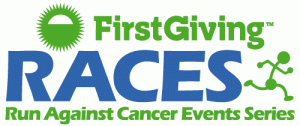
New Year’s Resolution that I haven’t yet broken: save Massachusetts from complete volunteer fail. When last we met, I got you thinking about civic engagement. Still crucial. But you can only vote so often (and early, for James Michael Curley). You know what you can do all the time though?
Go running.
I know, you’re starting to take this ‘go running’ hints personally. I’m not judging! You’re perfect just the way you are. But if you’re going to go for a jog ANYWAYS, you might as well jog for something. Like, say, fighting cancer.
You know who’s out fighting cancer lately? The gentlemen of RACE, J. Alain Ferry and my fellow Holy Cross alumni, Brendan Kearney. They’re not doctors or scientists; they’re runners, bikers, and good people out raising money for a good cause. What a great combination! They let me crash their post-run at Crossroads Pub on Thursday to tell me a bit about what they’re doing, how to participate, and who can help. (Hint: everyone.)
Starting Line
In 2007, Alain was at a Christmas party with his then-girlfriend, whose mother was fighting cancer. At the event, they ran into 1976 Boston Marathon winner Jack Fultz. (Can I just point out that I NEVER run into former Marathon winners? Never. Or if I do, I’m never aware of it).
In discussing Alain’s desire to put on an event and raise some money for Dana-Farber, Jack offered some good advice: Do it. In under 6 weeks, Alain had managed the logistics of organizing a race and obtaining city permitting to put on a Super Bowl race for 220 runners. By 2009, he had 1000 runners; by 2010, 1500.
As the race grew in popularity, Alain’s plans grew, too. He’d lost his father and his best friend to cancer, and certainly he wasn’t the only one affected by the disease. Alain, with his background deeper in cycling than running, called on Brendan and his running community contacts. Before long, plans to create a multi-race series were underway.
They brought in existing race organizers to join the series, hoping to get more runners to the established events. One organizer, Somerville Road Runners’ “Shifter,” is another Holy Cross grad. (Seriously, we’re everywhere. Bleed purple, Boston.) He’d lost his father to colon cancer, spent 18 years running with the Dana-Farber team, and, over a decade ago, began the race now known as “Shifter’s 5K” at a local bar. (Shifter sounded as excited about this year’s Shifter’s 5K post-party raffles as he does about the 5K itself). His race usually attracts over 300 people, he’s hoping the series will bring more runners and raise even more money. According to Brendan, the biggest event in the series is probably the James Joyce Ramble – it’s even been in the New York Times! You know the Times, it’s the paper you read after you’ve read ONEin3.
How can people get involved?
In 2011, there are plenty of opportunities to participate! Best of all, runners who complete all six events in the series get something! Not sure what yet, but Brendan guarantees it will be awesome. I’ll take his word for it. If you can’t make all six, run five – he promises a slightly less/but still very awesome prize. Again, I’m taking his word for it. If you sign up now for all six, you get a sweet gift at the end AND a free case of mix1 now. The fun doesn’t stop! So, mark your calendars:
- Feb 6th – Super Sunday 5K/10K (you’ll probably see me there, pregaming the big game with 6.2 miles+afterparty)
- April 2nd – Shifter’s 5K
- May 1st – James Joyce Ramble 10K
- May 8th – M.O.M.’s 5K
- June 19th – Father’s Day 10K
- June 30th – Squantum5
Have you thought about running the Boston Marathon for a charity, but are slightly (extremely) intimidated (terrified) by the fundraising? Not to worry - you can get your feet wet on a smaller scale with the series. They’ve teamed up with FirstGiving to help increase the charitable impact of each race and each runner - racers can set up their own fundraising page to directly benefit the charity beyond the cost of race entry. Pretty sweet, no? And you don’t even have to hoof it a whole 26.2!
Not a runner? Don’t sweat. Literally. If you want to help with logistics, race day stuff, contributing freebies for runners, coming up with raffle prizes, or you have no idea but want to give some time, they’re happy to have you. A good place to start – email Brendan@racemenu.com and tell him you want to help! Then show your love on facebook, follow them on twitter, and tell your friends to sign up to run or help.
Look at that. You’re a volunteer now. See how easy that was?



